| Contents
Home
General
Info
Ordering
Info
Contact us
Cartridge
Lists
Patent & Miscellaneous
Rim Fire
Center Fire Pistol
Center Fire Rifle
Metric Rimfire,
Pistol&Rifle
British Pistol and Rifle
Shotgun Shells
Posters
This Month's Picture Page
Index to
Picture Pages
Prior Picture Pages:
*
September 2003
*
October 2003
*
November 2003
*
December 2003
*
January 2004
*
February 2004
*
March 2004
*
April 2004
*
May 2004
*
June 2004
*
July 2004
*
August 2004
*
September 2004
*
October 2004
*
November 2004
*
December
2004
*
January 2005
*
February
2005
*
March
2005
*
April
2005
*
May 2005
* June 2005
* July 2005
*
August 2005
*
September
2005
*
October 2005
*
November 2005
*
December 2005
*
January 2006
*
February 2006
*
March 2006
*
April 2006
*
May 2006
Links to Other Sites
Cartridge Collectors Organizations:
IAA
ECRA
SAAACA
Auctions:
Auction
Arms
E-Bay
Ward's Collectibles
Sold USA
Books:
Armory
Publications
WCF Publications
Other Collector's Sites:
Curtis Steinhauer
|
Home of the Old Ammo Guy's Virtual
Cartridge Trading Table
Featuring a wide range of antique,
obsolete, and modern ammunition for collectors
Picture
Page
June
2006
A sniper's cartridge for the 21st
Century......
 The
oversized monster pictured to the right of the three smaller cartridges (.30-06,
7.62 NATO and 5.56 NATO) that became standard sniper fodder during the 20th
century is the .338 Lapua Magnum, also known as the 8.6 x 70mm to those who
continue tirelessly to embrace the metric system of measurement. This
cartridge is unusual, in that it was originally designed for long range
sniper use. Developed in 1983 for the U.S. Navy, the first of these
cartridges used 250 grain Hornady bullets and cases made by Brass Extrusion
Labs (B.E.L.L.). Velocity and accuracy are apparently pretty impressive to
those spend time pondering such things. Muzzle
velocity is just under 3000 fps; the bullet is still supersonic 1300 yards
down range. It is capable of reliable accuracy in excess of 1100 yards, well
beyond the range of the other three. The
oversized monster pictured to the right of the three smaller cartridges (.30-06,
7.62 NATO and 5.56 NATO) that became standard sniper fodder during the 20th
century is the .338 Lapua Magnum, also known as the 8.6 x 70mm to those who
continue tirelessly to embrace the metric system of measurement. This
cartridge is unusual, in that it was originally designed for long range
sniper use. Developed in 1983 for the U.S. Navy, the first of these
cartridges used 250 grain Hornady bullets and cases made by Brass Extrusion
Labs (B.E.L.L.). Velocity and accuracy are apparently pretty impressive to
those spend time pondering such things. Muzzle
velocity is just under 3000 fps; the bullet is still supersonic 1300 yards
down range. It is capable of reliable accuracy in excess of 1100 yards, well
beyond the range of the other three.
.
.
.
.
.
A 9 m/m Belgian Nagant cartridge.........
.One of those cartridges that tends to be seen much less often than the
firearm it was made for, this is the 9mm Nagant. Originally designed for use
in the Model 1878 Belgian Nagant revolver, it was used also in the Model
1883 Nagant, and saw service with the Belgian military until 1900, when it
was replaced by the FN Browning 7.65mm automatic pistol. The cartridge
continued to be produced by a number of European ammunition makers until just before World
War 1. These will be found with paper patched bullets, like this one, as
well as plain lead bullets. I have included a picture of a Model 1878 Nagant
revolver.
.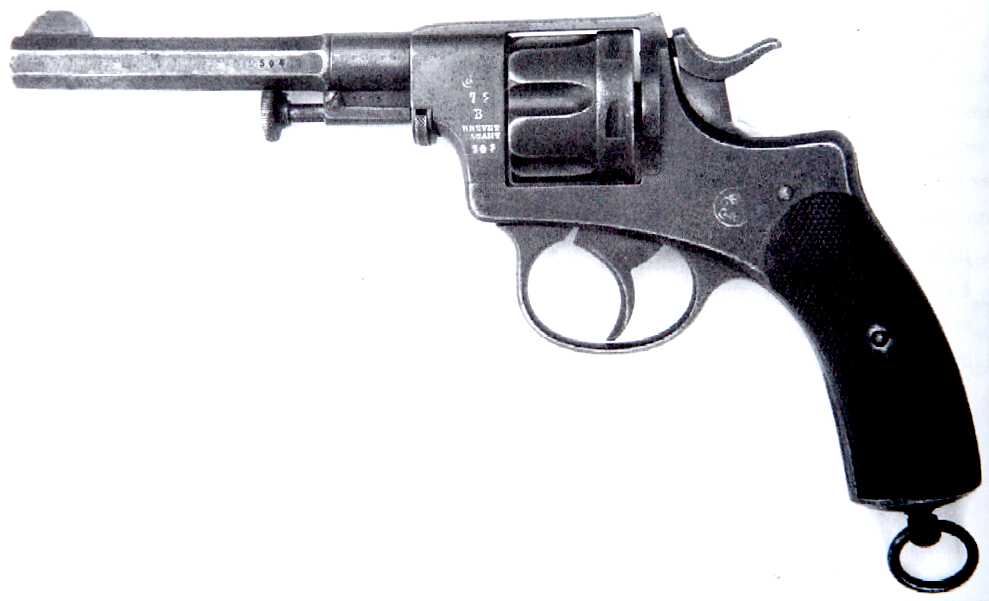 
.
.
.
.
.
.
.
A box of Peters .45 ACP Rustless Riot
Cartridges.....
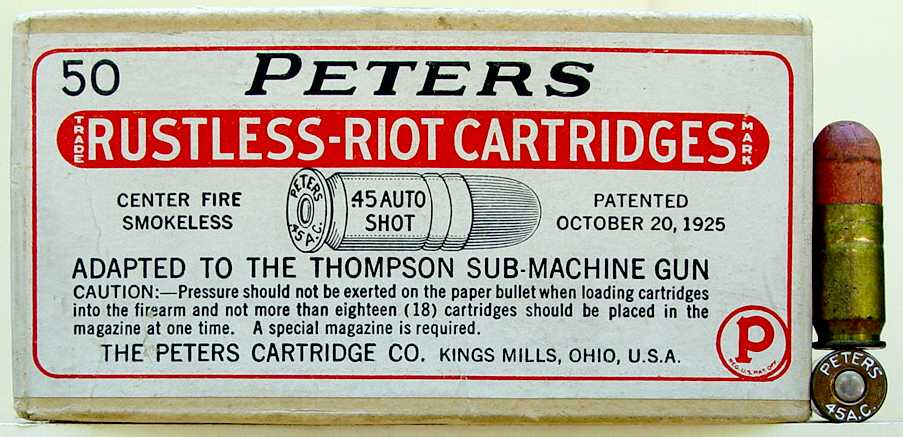 . .
Here's a really nice sealed box of Peters rustless .45 ACP shot
cartridges which were made to be used in the Thompson sub-machine gun for
riot control, and assuming the information on the box is to believed, they
were 'considered particularly effective for that purpose'.
According to the instructions on the top label, a special magazine was
required when firing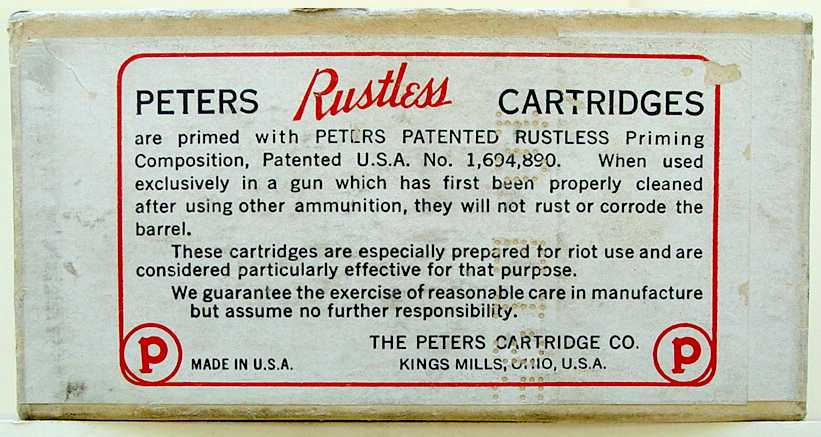 these cartridges. In addition, it was recommended that no more than 18
cartridges be loaded in the magazine; otherwise, the shot-filled paper
bullets might be crushed. This would render them incapable of being
fed into the chamber of the gun, causing the action to jam; which would
certainly not be a good thing when dealing with a rioting crowd, especially
after they've already been peppered a few times with birdshot. The patent for this shot cartridge was issued on
October 20, 1925, also noted on the top label. Patent # 1,557,696 was issued
on this date to Charles Le Roy Holden, who assigned it to Peters
these cartridges. In addition, it was recommended that no more than 18
cartridges be loaded in the magazine; otherwise, the shot-filled paper
bullets might be crushed. This would render them incapable of being
fed into the chamber of the gun, causing the action to jam; which would
certainly not be a good thing when dealing with a rioting crowd, especially
after they've already been peppered a few times with birdshot. The patent for this shot cartridge was issued on
October 20, 1925, also noted on the top label. Patent # 1,557,696 was issued
on this date to Charles Le Roy Holden, who assigned it to Peters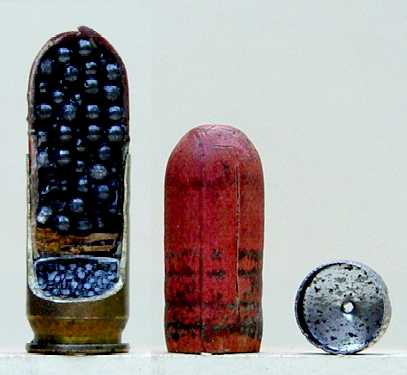 . His patent
covers a metal cup, loaded into the cartridge case beneath the paper shot
container, with
its open side towards the powder charge. He was issued another patent
(1,557,695) on that same day, which he filed with the patent office about a
year earlier than 1,557,696, and which has the metal cup turned in the opposite
direction. I assume this orientation of the cup didn't work as well,
resulting in the filing of the second patent application. The cup is designed to act as a gas
check to provide a seal which prevents the explosive gases produced by the
ignited powder charge from damaging or
passing by the shot container until it has reached the end of the barrel,
thereby allowing the shot to spread in a predictable pattern after leaving
the barrel, as well as maintaining uniform pressure to ensure the proper
functioning of the firearm. As can be seen in the picture with my rather poorly
sectioned cartridge, the metal cup looks very much like the cap that
fits onto the open end of a glass Christmas ornament. It even has the hole in the middle
through which passes the springy wire thing that the hook attaches to. . His patent
covers a metal cup, loaded into the cartridge case beneath the paper shot
container, with
its open side towards the powder charge. He was issued another patent
(1,557,695) on that same day, which he filed with the patent office about a
year earlier than 1,557,696, and which has the metal cup turned in the opposite
direction. I assume this orientation of the cup didn't work as well,
resulting in the filing of the second patent application. The cup is designed to act as a gas
check to provide a seal which prevents the explosive gases produced by the
ignited powder charge from damaging or
passing by the shot container until it has reached the end of the barrel,
thereby allowing the shot to spread in a predictable pattern after leaving
the barrel, as well as maintaining uniform pressure to ensure the proper
functioning of the firearm. As can be seen in the picture with my rather poorly
sectioned cartridge, the metal cup looks very much like the cap that
fits onto the open end of a glass Christmas ornament. It even has the hole in the middle
through which passes the springy wire thing that the hook attaches to.
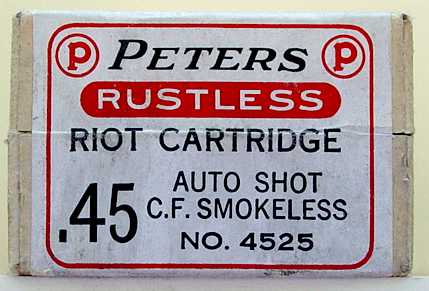 Being
the scrooge that I am, I can't help but think that Mr. Holden got the
inspiration for his patent while grudgingly fulfilling the traditional (and
usually infuriating) husband/father duties associated with the family
Christmas tree. The patent number
1,694,890 on the back label applies to the rustless priming mixture. This
patent was issued to Harley T. Peck on December 11, 1928, and also assigned
to the Peters Cartridge Company. Based on the progression of the patents, I
would have to assume that the very earliest of these Peters riot cartridges
will be found in boxes that are not marked "Rustless", and will have the
metal cup positioned with the open side towards the shot load rather than
the powder. Being
the scrooge that I am, I can't help but think that Mr. Holden got the
inspiration for his patent while grudgingly fulfilling the traditional (and
usually infuriating) husband/father duties associated with the family
Christmas tree. The patent number
1,694,890 on the back label applies to the rustless priming mixture. This
patent was issued to Harley T. Peck on December 11, 1928, and also assigned
to the Peters Cartridge Company. Based on the progression of the patents, I
would have to assume that the very earliest of these Peters riot cartridges
will be found in boxes that are not marked "Rustless", and will have the
metal cup positioned with the open side towards the shot load rather than
the powder.
.
.
|

 The
oversized monster pictured to the right of the three smaller cartridges (.30-06,
7.62 NATO and 5.56 NATO) that became standard sniper fodder during the 20th
century is the .338 Lapua Magnum, also known as the 8.6 x 70mm to those who
continue tirelessly to embrace the metric system of measurement. This
cartridge is unusual, in that it was originally designed for long range
sniper use. Developed in 1983 for the U.S. Navy, the first of these
cartridges used 250 grain Hornady bullets and cases made by Brass Extrusion
Labs (B.E.L.L.). Velocity and accuracy are apparently pretty impressive to
those spend time pondering such things. Muzzle
velocity is just under 3000 fps; the bullet is still supersonic 1300 yards
down range. It is capable of reliable accuracy in excess of 1100 yards, well
beyond the range of the other three.
The
oversized monster pictured to the right of the three smaller cartridges (.30-06,
7.62 NATO and 5.56 NATO) that became standard sniper fodder during the 20th
century is the .338 Lapua Magnum, also known as the 8.6 x 70mm to those who
continue tirelessly to embrace the metric system of measurement. This
cartridge is unusual, in that it was originally designed for long range
sniper use. Developed in 1983 for the U.S. Navy, the first of these
cartridges used 250 grain Hornady bullets and cases made by Brass Extrusion
Labs (B.E.L.L.). Velocity and accuracy are apparently pretty impressive to
those spend time pondering such things. Muzzle
velocity is just under 3000 fps; the bullet is still supersonic 1300 yards
down range. It is capable of reliable accuracy in excess of 1100 yards, well
beyond the range of the other three. 

 .
. these cartridges. In addition, it was recommended that no more than 18
cartridges be loaded in the magazine; otherwise, the shot-filled paper
bullets might be crushed. This would render them incapable of being
fed into the chamber of the gun, causing the action to jam; which would
certainly not be a good thing when dealing with a rioting crowd, especially
after they've already been peppered a few times with birdshot. The patent for this shot cartridge was issued on
October 20, 1925, also noted on the top label. Patent # 1,557,696 was issued
on this date to Charles Le Roy Holden, who assigned it to Peters
these cartridges. In addition, it was recommended that no more than 18
cartridges be loaded in the magazine; otherwise, the shot-filled paper
bullets might be crushed. This would render them incapable of being
fed into the chamber of the gun, causing the action to jam; which would
certainly not be a good thing when dealing with a rioting crowd, especially
after they've already been peppered a few times with birdshot. The patent for this shot cartridge was issued on
October 20, 1925, also noted on the top label. Patent # 1,557,696 was issued
on this date to Charles Le Roy Holden, who assigned it to Peters . His patent
covers a metal cup, loaded into the cartridge case beneath the paper shot
container, with
its open side towards the powder charge. He was issued another patent
(1,557,695) on that same day, which he filed with the patent office about a
year earlier than 1,557,696, and which has the metal cup turned in the opposite
direction. I assume this orientation of the cup didn't work as well,
resulting in the filing of the second patent application. The cup is designed to act as a gas
check to provide a seal which prevents the explosive gases produced by the
ignited powder charge from damaging or
passing by the shot container until it has reached the end of the barrel,
thereby allowing the shot to spread in a predictable pattern after leaving
the barrel, as well as maintaining uniform pressure to ensure the proper
functioning of the firearm. As can be seen in the picture with my rather poorly
sectioned cartridge, the metal cup looks very much like the cap that
fits onto the open end of a glass Christmas ornament. It even has the hole in the middle
through which passes the springy wire thing that the hook attaches to.
. His patent
covers a metal cup, loaded into the cartridge case beneath the paper shot
container, with
its open side towards the powder charge. He was issued another patent
(1,557,695) on that same day, which he filed with the patent office about a
year earlier than 1,557,696, and which has the metal cup turned in the opposite
direction. I assume this orientation of the cup didn't work as well,
resulting in the filing of the second patent application. The cup is designed to act as a gas
check to provide a seal which prevents the explosive gases produced by the
ignited powder charge from damaging or
passing by the shot container until it has reached the end of the barrel,
thereby allowing the shot to spread in a predictable pattern after leaving
the barrel, as well as maintaining uniform pressure to ensure the proper
functioning of the firearm. As can be seen in the picture with my rather poorly
sectioned cartridge, the metal cup looks very much like the cap that
fits onto the open end of a glass Christmas ornament. It even has the hole in the middle
through which passes the springy wire thing that the hook attaches to.
 Being
the scrooge that I am, I can't help but think that Mr. Holden got the
inspiration for his patent while grudgingly fulfilling the traditional (and
usually infuriating) husband/father duties associated with the family
Christmas tree. The patent number
1,694,890 on the back label applies to the rustless priming mixture. This
patent was issued to Harley T. Peck on December 11, 1928, and also assigned
to the Peters Cartridge Company. Based on the progression of the patents, I
would have to assume that the very earliest of these Peters riot cartridges
will be found in boxes that are not marked "Rustless", and will have the
metal cup positioned with the open side towards the shot load rather than
the powder.
Being
the scrooge that I am, I can't help but think that Mr. Holden got the
inspiration for his patent while grudgingly fulfilling the traditional (and
usually infuriating) husband/father duties associated with the family
Christmas tree. The patent number
1,694,890 on the back label applies to the rustless priming mixture. This
patent was issued to Harley T. Peck on December 11, 1928, and also assigned
to the Peters Cartridge Company. Based on the progression of the patents, I
would have to assume that the very earliest of these Peters riot cartridges
will be found in boxes that are not marked "Rustless", and will have the
metal cup positioned with the open side towards the shot load rather than
the powder.